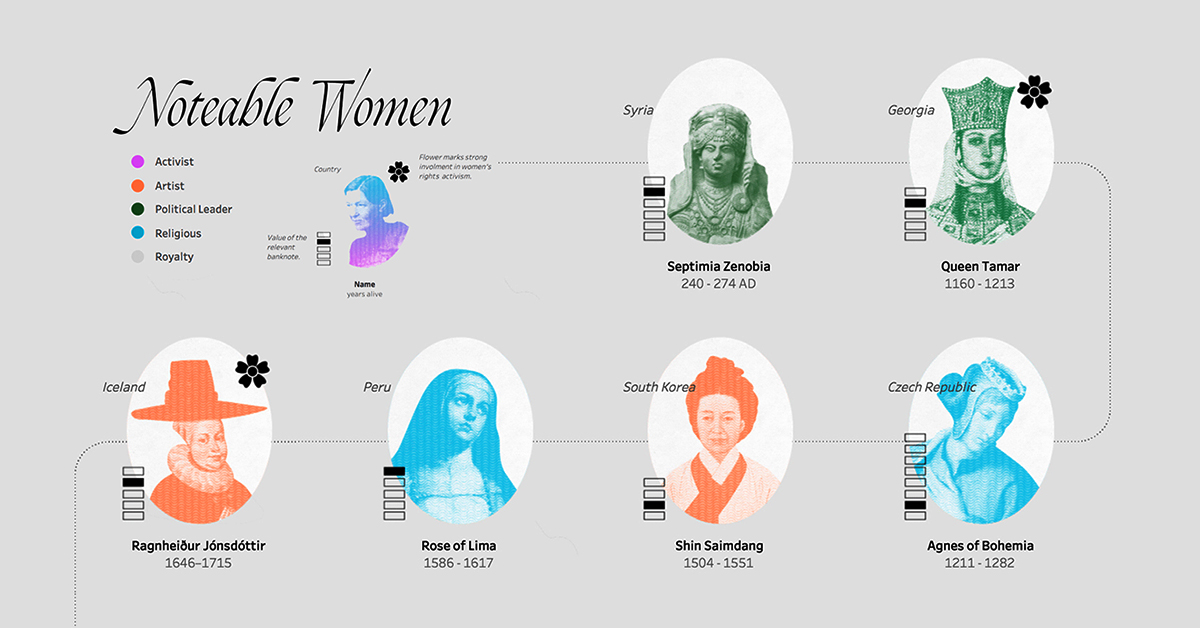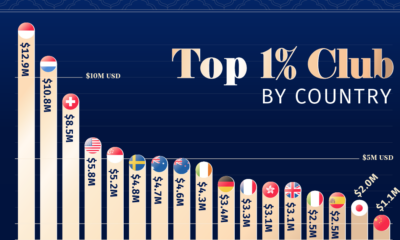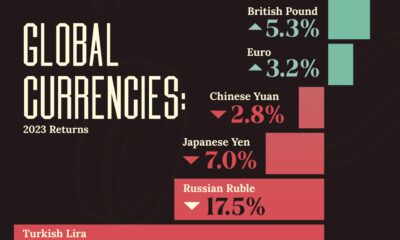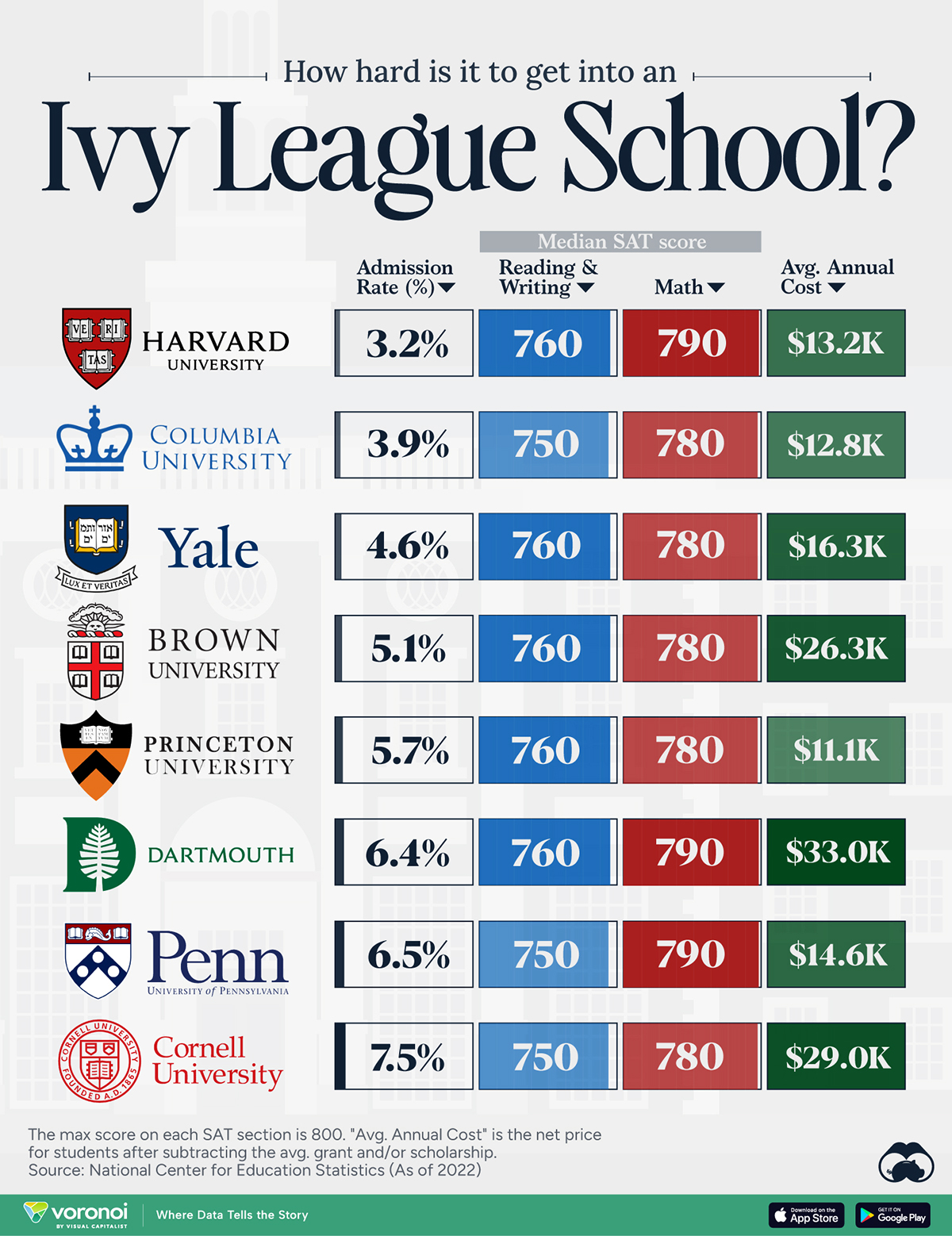Misc
Which Countries Feature Women on Banknotes?

Visualizing the Women on Banknotes Worldwide
A study by Swedish loan company Advisa analyzed 1,006 current international banknotes and found that only 15% featured images of women.
Who are these women, and which countries feature them on their bills?
This graphic by Ivett Kovács and Gabrielle Merite visualizes women on banknotes around the world, showing their main occupations, and the value of the banknotes they’re featured on.
The List: Women on Bills
To create this graphic, Ivett used data from the Standard Catalogue of World Paper Money, compiled by Vox.
According to the dataset, Queen Elizabeth II is the most featured woman worldwide.
| Country | Denomination(s) | Woman | Description |
|---|---|---|---|
| 🇦🇱 Albania | 100 lekë | Queen Teuta | Queen of Illyria |
| 🇦🇬 Antigua and Barbuda | $5, $10, $20, $50, $100 | Queen Elizabeth II | Queen of U.K., CAN, AUS, NZ+ |
| 🇦🇷 Argentina | 100 pesos | Eva Perón | First Lady of Argentina |
| 🇦🇺 Australia | $50 | Edith Cowan | Suffragette |
| 🇦🇺 Australia | $10 | Mary Gilmore | Poet, journalist |
| 🇦🇺 Australia | $100 | Nellie Melba | Opera singer |
| 🇦🇺 Australia | $5 | Queen Elizabeth II | Queen of U.K., CAN, AUS, NZ+ |
| 🇧🇸 Bahamas | $10, $100 | Queen Elizabeth II | Queen of U.K., CAN, AUS, NZ+ |
| 🇧🇿 Belize | $2, $10, $20, $50 | Queen Elizabeth II | Queen of U.K., CAN, AUS, NZ+ |
| 🇨🇦 Canada | $20 | Queen Elizabeth II | Queen of U.K., CAN, AUS, NZ+ |
| 🇨🇻 Cape Verde | 2000 escudos | Cesária Évora | Singer |
| 🇰🇾 Cayman Islands | $1, $5, $10, $25, $50, $100 | Queen Elizabeth II | Queen of U.K., CAN, AUS, NZ+ |
| 🇨🇱 Chile | 5000 pesos | Gabriela Mistral | Nobel Prize winner |
| 🇨🇴 Colombia | 10000 pesos | Policarpa Salavarrieta | Seamstress, spy |
| 🇨🇷 Costa Rica | 20000 colones | Carmen Lyra | Writer |
| 🇨🇿 Czech Republic | 50 koruna | Agnes of Bohemia | Bohemian princess |
| 🇨🇿 Czech Republic | 500 koruna | Božena Němcová | Writer |
| 🇨🇿 Czech Republic | 2000 koruna | Emmy Destinn | Opera singer |
| 🇩🇲 Dominica | $5, $10, $20, $50, $100 | Queen Elizabeth II | Queen of U.K., CAN, AUS, NZ+ |
| 🇩🇴 Dominican Republic | 200 pesos | Mirabal sisters | Sisters who opposed dictatorship |
| 🇩🇴 Dominican Republic | 500 pesos | Salomé Ureña | Poet and pedagogist |
| 🇫🇰 Falkland Islands | 5, 10, 20, 50 pounds | Queen Elizabeth II | Queen of U.K., CAN, AUS, NZ+ |
| 🇬🇪 Georgia | 50 lari | Queen Tamar | The Queen Regnant of Georgia |
| 🇬🇮 Gibraltar | 5, 10, 20, 50 pounds | Queen Elizabeth II | Queen of U.K., CAN, AUS, NZ+ |
| 🇬🇩 Grenada | $5, $10, $20, $50, $100 | Queen Elizabeth II | Queen of U.K., CAN, AUS, NZ+ |
| 🇬🇬 Guernsey | 5, 10, 20, 50 pounds | Queen Elizabeth II | Queen of U.K., CAN, AUS, NZ+ |
| 🇭🇹 Haiti | 10 gourdes | Catherine Flon Arcahaie | Created Haitian flag |
| 🇮🇸 Iceland | 5000 kronur | Ragnheiður Jónsdóttir | Seamstress |
| 🇮🇲 Isle of Man | 1, 5, ,10, 20, 50 pounds | Queen Elizabeth II | Queen of U.K., CAN, AUS, NZ+ |
| 🇯🇲 Jamaica | $500 | Nanny of the Maroons | National heroine of Jamaica |
| 🇯🇵 Japan | 5000 yen | Higuchi Ichiyō | Writer |
| 🇯🇪 Jersey | 1 ,5, 10, 20, 50 pounds | Queen Elizabeth II | Queen of U.K., CAN, AUS, NZ+ |
| 🇰🇬 Kyrgyzstan | 50 som | Kurmanjan Datka | Stateswoman |
| 🇲🇼 Malawi | 200 kwacha | Rose Lomathinda Chibambo | Leader of African Congress |
| 🇲🇽 Mexico | 500 pesos | Frida Kahlo (and Diego Rivera) | Artist, Communist Party militant |
| 🇲🇽 Mexico | 200 pesos | Sor Juana Inés de la Cruz | Nun, scholar, poet |
| 🇳🇿 New Zealand | $10 | Kate Sheppard | Suffragette |
| 🇳🇿 New Zealand | $20 | Queen Elizabeth II | Queen of U.K., CAN, AUS, NZ+ |
| 🇳🇬 Nigeria | 20 naira | Ladi Kwali | Potter |
| 🇳🇴 Norway | 100 kroner | Kirsten Falgstad | Opera singer |
| 🇳🇴 Norway | 500 kroner | Sigrid Undset | Nobel Prize winner |
| 🇵🇪 Peru | 200 soles | Rose of Lima | First catholic saint of the Americas |
| 🇵🇭 Philippines | 500 pesos | Corazon C. Aquino | First female president in Phillipines |
| 🇵🇭 Philippines | 1000 pesos | Josefa Llanes Escoda | Founder, Philippines Girl Scouts |
| 🇰🇳 St. Kitts and Nevis | $5, $10, $20, $50, $100 | Queen Elizabeth II | Queen of U.K., CAN, AUS, NZ+ |
| 🇱🇨 St. Lucia | $5, $10, $20, $50, $100 | Queen Elizabeth II | Queen of U.K., CAN, AUS, NZ+ |
| 🏴 Scotland | 50 pounds | Mary Slessor | Missionary, activist |
| 🇷🇸 Serbia | 200 dinar | Nadežda Petrović | Painter |
| 🇰🇷 South Korea | 50000 won | Shin Saimdang | Artist, poet |
| 🇻🇨 St Vincent and Grenadines | $5, $10, $20, $50, $100 | Queen Elizabeth II | Queen of U.K., CAN, AUS, NZ+ |
| 🇸🇭 St. Helena | 5, 10, 20 pounds | Queen Elizabeth II | Queen of U.K., CAN, AUS, NZ+ |
| 🇸🇪 Sweden | 20 kronor | Astrid Lindgren | Author of "Pippi Lockstocking" |
| 🇸🇪 Sweden | 50 kronor | Jenny Lind | Opera singer |
| 🇸🇪 Sweden | 500 kronor | Birgit Nilsson | Opera singer |
| 🇸🇪 Sweden | 100 kronor | Greta Garbo | Actress |
| 🇨🇭 Switzerland | 50 francs | Sophie Taeuber-Arp | Painter, sculptor |
| 🇸🇾 Syria | 500 pounds | Zenobia | Queen of the Palmyrene Empire |
| 🇹🇳 Tunisia | 10 dinars | Dido | Queen & founder of Carthage |
| 🇹🇷 Turkey | 50 lira | Fatma Aliye Topuz | First female Muslim novelist |
| 🇺🇦 Ukraine | 200 hryven | Lesya Ukrainka | Poet, writer |
| 🇬🇧 United Kingdom | 5, 10, 20, 50 pounds | Queen Elizabeth II | Queen of U.K., CAN, AUS, NZ+ |
| 🇬🇧 United Kingdom | 5 pounds | Elizabeth Fry | Prison reformer |
| 🇺🇾 Uruguay | 1000 pesos | Juana de Ibarbourou | Poet |
| 🇻🇪 Venezuela | 20 bolívares | Luisa Cáceres de Arismendi | Heroine of War of Independence |
Canada was the first country to use an image of Queen Elizabeth II on their money. In 1935, Canada printed her on a $20 banknote—the British monarch was only a 9-year-old princess at the time. Now, Queen E appears on a variety of different banknotes in 19 different countries. In the Cayman Islands, she’s on their $1, $5, $25, $50, and $100.
A few other queens or royal members have made it onto different banknotes too—Georgia’s 50 lari note has an image of Queen Tamar, who was the Queen of Georgia from 1184 to 1213, and Albania’s 100 lekë features Queen Teuta, a 3rd century queen of an Illyrian tribe.
While royals (especially Queen Elizabeth II) are frequently featured on bills worldwide, women in other positions have also made it onto banknotes.
Authors, singers, poets, and painters are featured on a number of different currencies. For instance, Sweden has Astrid Lindgren—the author of Pippi Longstocking—on their 20 kronor.
Sweden also features three other women on their bills: Birgit Nilsson, Jenny Lind, and Greta Garbo, making their banknote features an even 50/50 split between men and women.
A Quick History of Women Featured on U.S. Banknotes
Essentially the only time a woman was prominently featured on a U.S. banknote was in the late 19th century when Martha Washington—the wife of President George Washington—appeared on a $1 silver certificate.
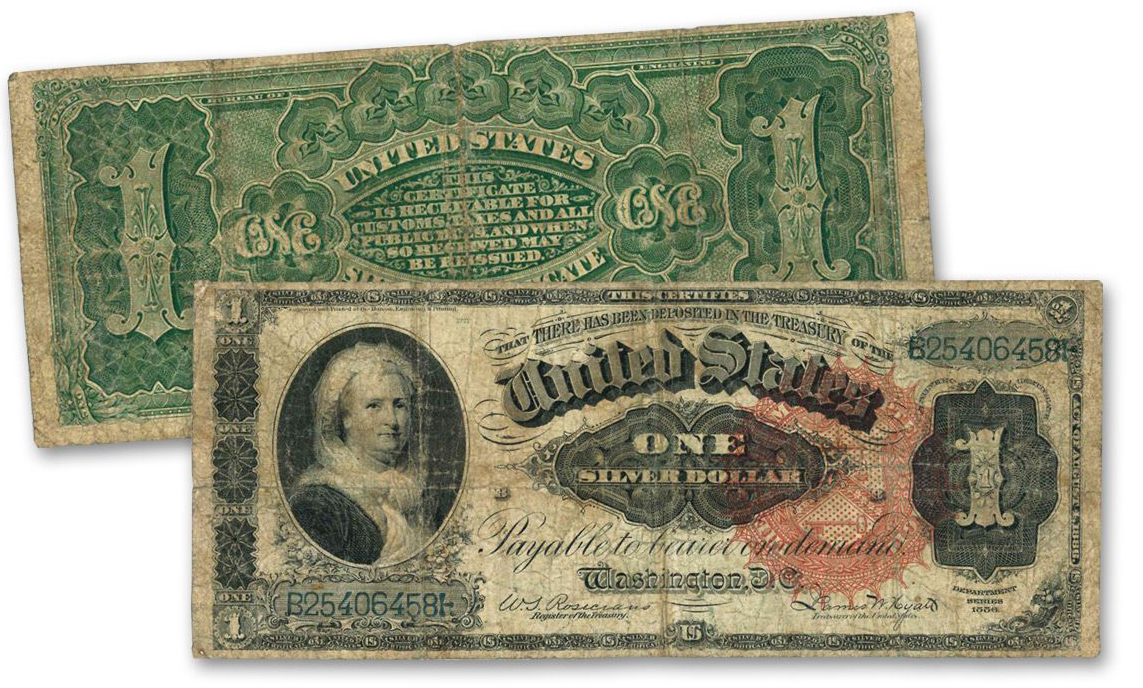
This dearth of women on U.S. banknotes may soon come to an end. The Biden administration is now speeding up efforts to put Harriet Tubman on the $20 bill, an initiative that was delayed in recent years. When the plan was initially introduced by then Treasury secretary, Jacob Lew, in 2016, the new design was set to be unveiled in 2020 on the centennial of the 19th Amendment (which granted women the right to vote).
Women are Still Underrepresented
It’s worth noting that women are still consistently underrepresented in positions of power, and in the media.
And even when women do hold authoritative positions, research has shown they’re taken less seriously than their male counterparts.
That’s why events like International Women’s Day exist. It’s not just a time to celebrate women’s achievements—it’s also a day to shed light on existing gender bias, and ultimately take action to help combat gender inequality.
Want to be part of the change? Learn more about Women’s Day, or donate to fundraising efforts for female-focused charities.

This article was published as a part of Visual Capitalist's Creator Program, which features data-driven visuals from some of our favorite Creators around the world.
Misc
How Hard Is It to Get Into an Ivy League School?
We detail the admission rates and average annual cost for Ivy League schools, as well as the median SAT scores required to be accepted.
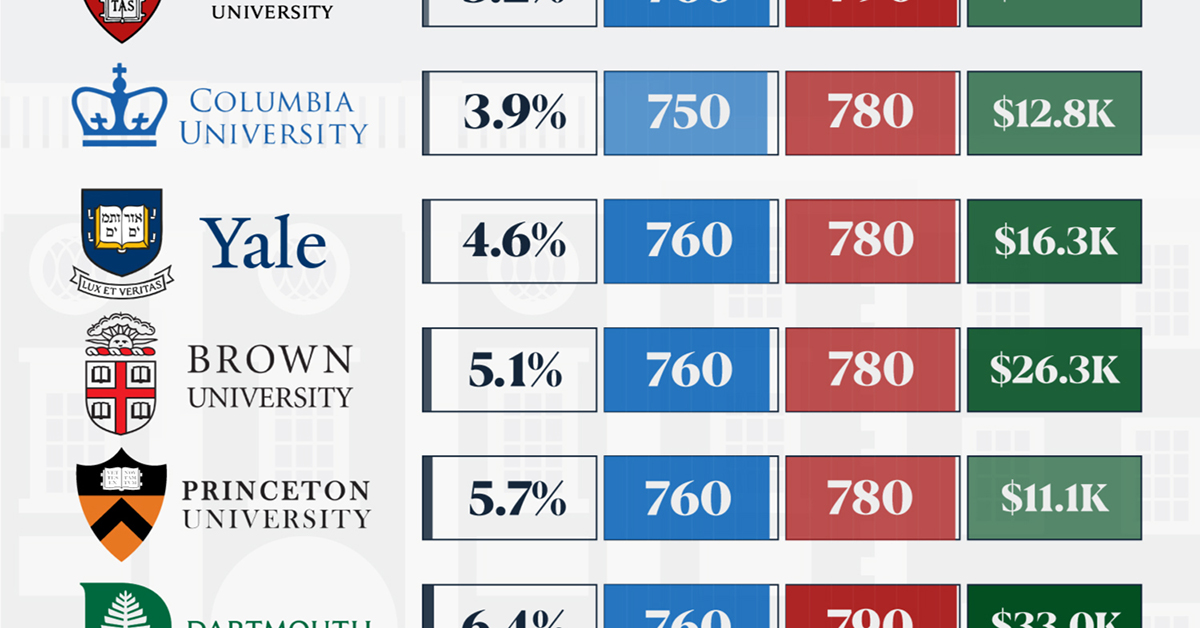
How Hard Is It to Get Into an Ivy League School?
This was originally posted on our Voronoi app. Download the app for free on iOS or Android and discover incredible data-driven charts from a variety of trusted sources.
Ivy League institutions are renowned worldwide for their academic excellence and long-standing traditions. But how hard is it to get into one of the top universities in the U.S.?
In this graphic, we detail the admission rates and average annual cost for Ivy League schools, as well as the median SAT scores required to be accepted. The data comes from the National Center for Education Statistics and was compiled by 24/7 Wall St.
Note that “average annual cost” represents the net price a student pays after subtracting the average value of grants and/or scholarships received.
Harvard is the Most Selective
The SAT is a standardized test commonly used for college admissions in the United States. It’s taken by high school juniors and seniors to assess their readiness for college-level academic work.
When comparing SAT scores, Harvard and Dartmouth are among the most challenging universities to gain admission to. The median SAT scores for their students are 760 for reading and writing and 790 for math. Still, Harvard has half the admission rate (3.2%) compared to Dartmouth (6.4%).
| School | Admission rate (%) | SAT Score: Reading & Writing | SAT Score: Math | Avg Annual Cost* |
|---|---|---|---|---|
| Harvard University | 3.2 | 760 | 790 | $13,259 |
| Columbia University | 3.9 | 750 | 780 | $12,836 |
| Yale University | 4.6 | 760 | 780 | $16,341 |
| Brown University | 5.1 | 760 | 780 | $26,308 |
| Princeton University | 5.7 | 760 | 780 | $11,080 |
| Dartmouth College | 6.4 | 760 | 790 | $33,023 |
| University of Pennsylvania | 6.5 | 750 | 790 | $14,851 |
| Cornell University | 7.5 | 750 | 780 | $29,011 |
*Costs after receiving federal financial aid.
Additionally, Dartmouth has the highest average annual cost at $33,000. Princeton has the lowest at $11,100.
While student debt has surged in the United States in recent years, hitting $1.73 trillion in 2023, the worth of obtaining a degree from any of the schools listed surpasses mere academics. This is evidenced by the substantial incomes earned by former students.
Harvard grads, for example, have the highest average starting salary in the country, at $91,700.
-

 Real Estate2 weeks ago
Real Estate2 weeks agoVisualizing America’s Shortage of Affordable Homes
-

 Technology1 week ago
Technology1 week agoRanked: Semiconductor Companies by Industry Revenue Share
-

 Money1 week ago
Money1 week agoWhich States Have the Highest Minimum Wage in America?
-

 Real Estate1 week ago
Real Estate1 week agoRanked: The Most Valuable Housing Markets in America
-

 Business2 weeks ago
Business2 weeks agoCharted: Big Four Market Share by S&P 500 Audits
-

 AI2 weeks ago
AI2 weeks agoThe Stock Performance of U.S. Chipmakers So Far in 2024
-

 Misc2 weeks ago
Misc2 weeks agoAlmost Every EV Stock is Down After Q1 2024
-

 Money2 weeks ago
Money2 weeks agoWhere Does One U.S. Tax Dollar Go?

